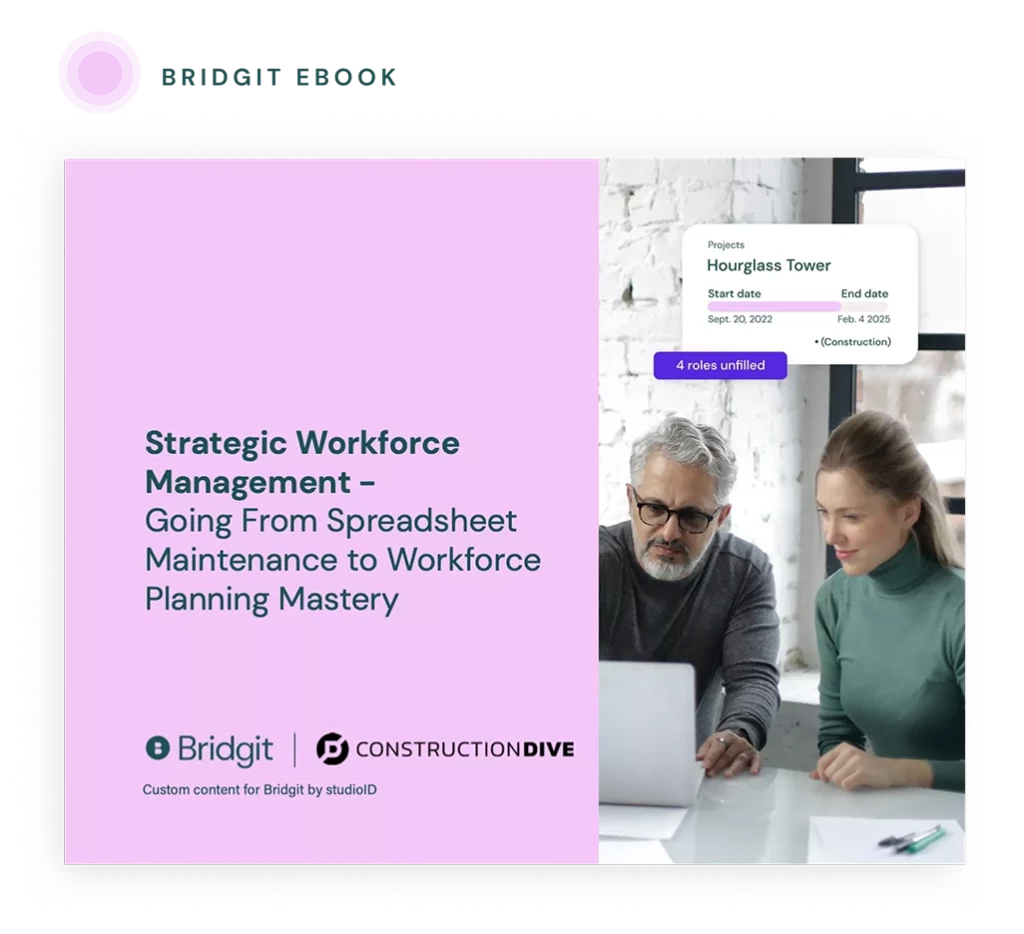As the construction industry continues to move forward and embrace the digital transformation of its core processes, focusing on data analysis will become more important for all leadership and construction management positions. Construction is trying to shift from manual processes to cloud-based, automated software and technology for workforce planning. That shift will inevitably result in a wealth of project and workforce data being captured from every project phase.
Table of Contents
Using data to make informed workforce planning decisions
According to FMI, 95% of all the data captured in the construction industry goes unused. On top of that, 13% of construction teams’ working hours are spent looking for the correct project data and information to keep projects moving forward.
As with most industries shifting to digital, there’s likely only a handful of people employed by general contractors with the specialized skills to analyze and pull key takeaways from your data when stored in a spreadsheet system. It’s essential that your organization:
- It makes data analysis approachable for team members who aren’t “data experts”
- Clearly defines what success means and then measures it
- Ensures the right people have access to the data they need
- Puts a focus on education and the benefits of being a data-driven culture
- Consistently make and communicate workforce decisions supported by data
This article will discuss a few steps your organization can take to build a data-driven culture.
In a recent post, the Harvard Business Review (HBR) identified the struggles in shifting to a data-driven business as often not simply a technical struggle but also a cultural one.
HBR has compiled a list of data commandments that can help create and maintain a data-driven culture. We will outline some of their essential suggestions and narrow the scope to discuss what that means for the construction industry.

Looking to be more strategic with your people?
We partnered with Construction Dive to outline the steps any contractor can take to be more strategic with their workforce management.
Data-driven workforce planning starts at the top
General contractors that pave the way for data-driven cultures do so by having their leadership set the expectation that accurate data must support decisions before making decisions. Leadership needs to enforce this as a regular process, not occasionally.
Your operations and project management teams should lead by example. For instance, before workforce planning meetings, your teams should regularly update and consolidate all relevant information and spend time preparing to discuss project progress, changes they think should be made, and the data to support those changes. Making this a regular practice helps to extend the culture downwards throughout your company. It demonstrates how decisions are actively being made and the data supporting them. Team members who want their input taken seriously will begin to adapt their approach to be centered around actionable data.
Allow your team to access workforce data regularly
We hear about this often in the construction industry. Data is often maintained in spreadsheets, and the team member responsible for maintaining the data is understandably hesitant to allow access. Human error and altered formulas can quickly make a spreadsheet unorganized or break it, requiring dozens of hours to fix. However, by denying access, the team members looking to use data to support their decisions will always come up short, and your data-driven culture won’t get off the ground.
Let’s use workforce planning meetings as an example again. For a general contractor looking to allow access to their workforce data, it’s a good idea to start slow. There are alternatives to spreadsheet systems that’ll allow you to grant different access to team members and not only dramatically limit their impact on the data but also present your data in an easy-to-understand way that doesn’t require them to be “data experts.”
Construction workforce planning solutions like Bridgit Bench allow administrators to create custom permission groups. By doing so, they can differentiate access levels to their workforce plan for their operations team, project managers, and superintendents. Everyone has access to view the data that will support their decisions, but the risk of human error is gone.
Consistently with the “top-down” approach to building a data-driven workforce plan, ensure your leadership team can access data to create metrics and data-based company strategies.
Quantify uncertainties into issues that can be solved
Knowing with absolute certainty is impossible. However, HBR suggests that requiring your leadership and project teams to quantify their uncertainty can have three powerful effects on your organization.
- It forces decision-makers to grapple with potential sources of uncertainty. Is the data accurate and reliable? How can new factors be incorporated when there isn’t existing data? These questions can often lead to uncovering new ways of updating processes and problem-solving.
- Your data analysis provides a deeper understanding of your models when evaluating uncertainty. This can help to paint a more accurate picture when running scenarios with active project bids based on the likelihood of winning/losing bids.
- Understanding uncertainty will also push your organization to run experiments. Whether it’s trying out a project team that’s never worked together or taking on a project your organization hasn’t managed before, “trial and error” allows for small opportunities to discover new methods to support widespread changes.
Keep training relevant and at the right time
It’s standard for general contractors to invest in large training efforts that include as many team members as possible to save on costs. The problem is that team members who don’t have a chance to immediately put that training into practice will often forget what they’ve learned. Offering training that leads directly to the practical application of new skills will help reinforce those skills and create a foundation of confidence when using data to support decision-making.
Be sure to also communicate to your team how using data will positively impact their work. If you vaguely explain how using data effectively will affect the company in the long run, team members may hesitate to abandon current practices and revamp their work. If you communicate how it will benefit them as individuals – avoiding rework and saving time – they’re more likely to invest in the change.
Explain analytical choices to provide more clarity
Ask your teams about the steps to approach a project decision. Ask what alternatives were considered, the positive and negative trade-offs, and ultimately, why the end decision was made. This will enable your team to consider options and change previous assumptions when solving problems. If a member of your operations team assembles project teams differently and uses data to explain their methodology, it can help enlighten everyone else with a similar role.
Like most industries, general contractors (and the different teams and divisions within them) will hesitate to shift to data-driven decision-making. The alternatives often seem risky, incur a new cost, or appear challenging to enforce company-wide. Having accessible data helps provide evidence and support for new ideas. It gives operations teams the confidence to adopt new or improved processes without feeling like they’re jumping into the unknown. Creating a data-driven culture isn’t easy. It requires leadership to lead by example and develop expectations for the rest of the team, but once you’ve started taking steps to make the shift, you’ll see decision-making in a new light.
Bridgit Bench is the leader in construction workforce planning because it makes data analysis approachable for every member of your team. We aim to enable operations teams to make data-driven decisions regarding workforce and project planning by providing customizations that allow general contractors to track people and project data specific to their company needs. Bridgit Bench will also help to understand your workforce utilization better and match your teams’ titles and availability to unfilled project roles to maximize productivity.
Think your workforce planning meetings could be more productive?
Download our ebook to learn how to run efficient, effective workforce planning meetings with your team.




